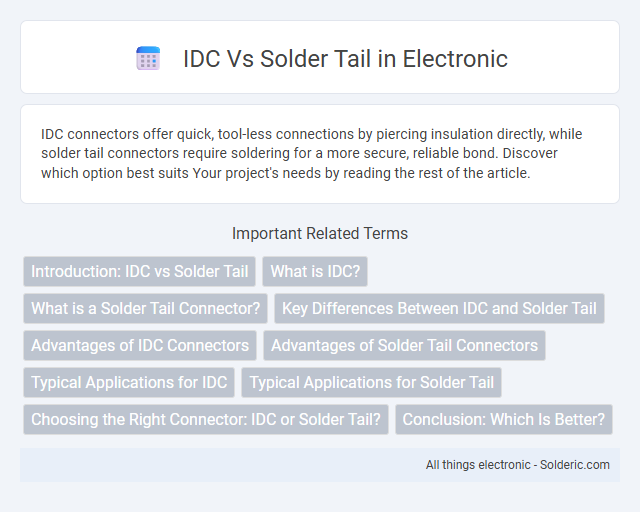IDC connectors offer quick, tool-less connections by piercing insulation directly, while solder tail connectors require soldering for a more secure, reliable bond. Discover which option best suits Your project's needs by reading the rest of the article.
Comparison Table
| Feature | IDC (Insulation-Displacement Connector) | Solder Tail Connector |
|---|---|---|
| Connection Type | Insulation-displacement (no stripping needed) | Soldered wire connection |
| Assembly Time | Fast, tool-assisted termination | Slower, manual soldering required |
| Reliability | Good mechanical retention, less susceptible to human error | Very reliable if soldered correctly |
| Rework & Maintenance | Easy to disconnect and reconnect | Requires desoldering for rework |
| Environmental Resistance | Moderate, can be less water/chemical resistant | Generally better sealing when combined with potting or sleeves |
| Typical Applications | Telecommunications, data cables, rapid assembly | High-reliability electronics, aerospace, rugged environments |
| Cost | Lower tooling and labor costs | Higher labor and process cost |
Introduction: IDC vs Solder Tail
IDC (Insulation Displacement Connector) and Solder Tail connectors offer distinct advantages in electronic assembly; IDC connectors ensure quick, reliable connections without soldering by piercing insulation to make contact, while Solder Tail connectors require manual soldering, providing strong mechanical and electrical bonds ideal for high-vibration environments. Choosing between IDC vs Solder Tail depends on your project's needs for assembly speed, durability, and maintenance flexibility. IDC connectors excel in rapid installations and easy replacements, whereas Solder Tail connectors are preferred for permanent, high-reliability connections.
What is IDC?
IDC (Insulation Displacement Connector) is a type of electrical connector designed to connect a wire without the need for stripping its insulation, using a special slot that cuts into the insulation to make contact with the conductor. Unlike solder tail connectors, which require soldering wires manually, IDC connectors provide a faster, more reliable connection ideal for mass production and field installations. Your choice of IDC can improve assembly speed and reduce the risk of connection failures in wiring systems.
What is a Solder Tail Connector?
A solder tail connector is an electrical component designed with metal pins or tails that are inserted into a PCB and soldered for a secure, permanent connection, ensuring robust mechanical and electrical performance. Unlike IDC (Insulation Displacement Connector), which connects by piercing wire insulation, solder tail connectors provide superior reliability in high-vibration and high-frequency environments. These connectors are widely used in industrial automation, telecommunications, and automotive electronics due to their excellent signal integrity and durability.
Key Differences Between IDC and Solder Tail
IDC connectors feature insulation displacement technology that allows quick, reliable wire termination without stripping insulation, making them ideal for high-volume assembly. Solder tail connectors require individual wires to be soldered directly to the pins, providing a secure, low-resistance electrical connection suited for precise, durable applications. Your choice depends on whether you prioritize manufacturing speed and ease (IDC) or long-term mechanical stability and electrical performance (solder tail).
Advantages of IDC Connectors
IDC connectors offer rapid, reliable termination without the need for soldering, significantly reducing assembly time and labor costs. Their insulation displacement technology ensures consistent electrical connection and excellent signal integrity, minimizing errors compared to solder tail connectors. The ability to accommodate multiple wires simultaneously enhances efficiency in complex wiring harnesses and industrial applications.
Advantages of Solder Tail Connectors
Solder tail connectors offer superior mechanical stability and enhanced electrical conductivity due to their robust solder joint with the PCB. They provide reliable high-frequency signal transmission and greater resistance to vibration and thermal cycling compared to IDC connectors. These advantages make solder tail connectors ideal for demanding applications in aerospace, automotive, and industrial electronics.
Typical Applications for IDC
IDC connectors are widely used in telecommunications, networking, and industrial automation for quick and reliable mass termination of ribbon cables. Your projects benefit from their ability to connect multiple wires simultaneously without stripping insulation, making them ideal for structured cabling and data transmission. These connectors ensure consistent electrical performance in environments requiring rapid assembly and maintenance.
Typical Applications for Solder Tail
Solder tail connectors are commonly used in high-density circuit boards where reliable, permanent electrical connections are essential, such as in automotive electronics, industrial automation, and consumer electronics. Their ability to provide robust mechanical strength and excellent solder joint integrity makes them ideal for applications involving high vibration or thermal cycling. Solder tail connectors also suit compact designs requiring consistent signal transmission and durability in harsh environments.
Choosing the Right Connector: IDC or Solder Tail?
Choosing between IDC and solder tail connectors depends on your application requirements and assembly process. IDC connectors provide quick, reliable connections without soldering, ideal for rapid prototyping or field repairs, while solder tail connectors offer stronger, more durable joins suited for high vibration or permanent installations. Evaluating cable type, environmental conditions, and production volume will help you determine the optimal connector for your project.
Conclusion: Which Is Better?
IDC connectors offer fast, reliable mass termination with minimal soldering, making them ideal for high-volume applications requiring quick assembly. Solder tail connectors provide superior electrical durability and mechanical strength, suitable for environments demanding long-term reliability and robust signal integrity. The choice between IDC and solder tail hinges on prioritizing speed and ease of installation versus enhanced durability and performance.
IDC vs Solder tail Infographic

 solderic.com
solderic.com